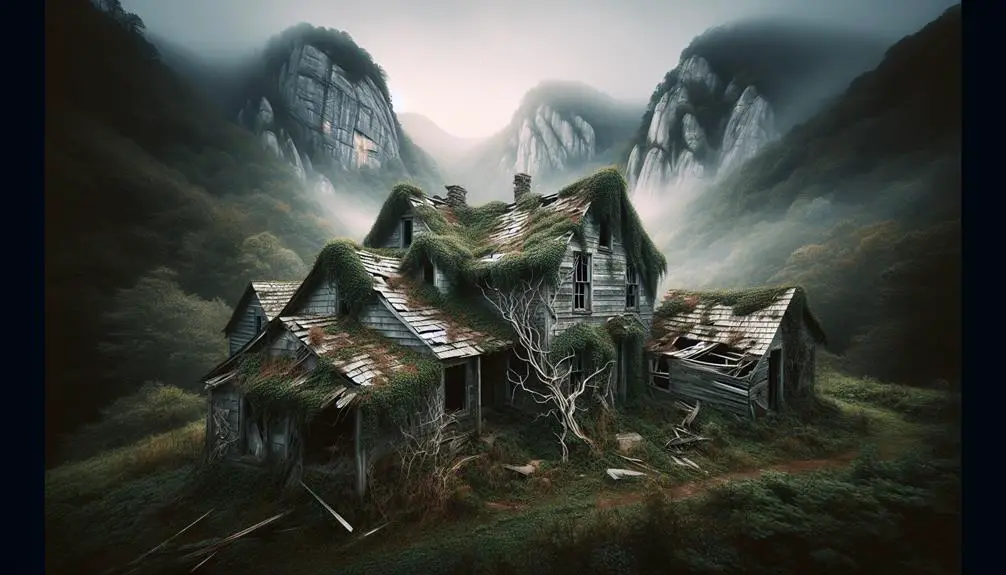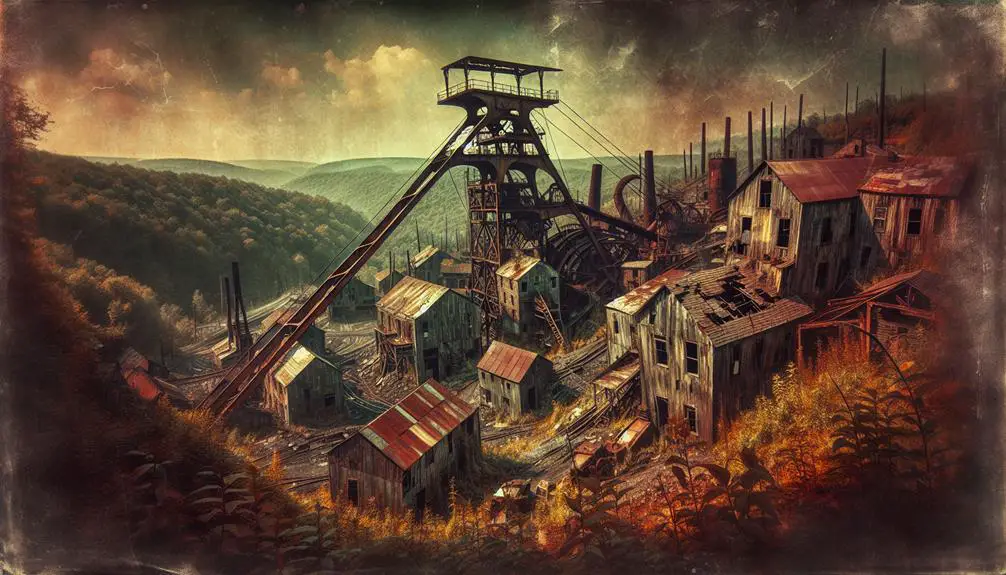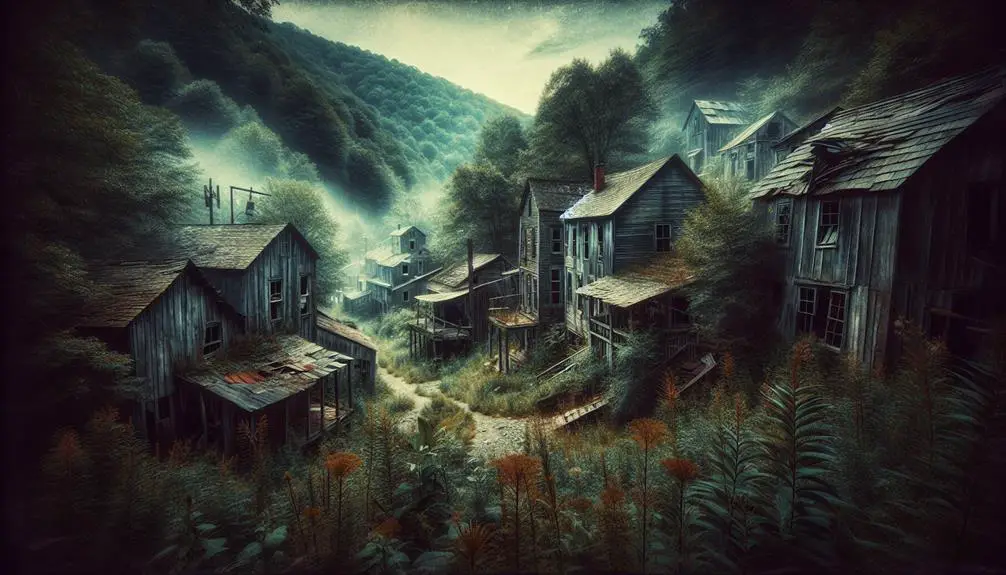In Appalachian mountain ghost towns, the decay is uniquely shaped by weathering, erosion, and vegetation. Historical importance and economic struggles led to abandonment. Deterioration mirrors societal shifts and fading customs. Architectural features like faded paint, collapsed roofs, and overgrown vegetation tell compelling stories. Preservation efforts balance authenticity and stability with challenges like funding struggles. The convergence of these forces creates hauntingly beautiful remnants that offer a glimpse into a bygone era.
Key Points
- Appalachian ghost towns display weathering patterns from relentless natural forces.
- Abandoned buildings reveal historical significance of once vibrant communities.
- Deterioration reflects societal shifts and changing cultural values over time.
- Unique architectural decay features like faded paint and overgrown vegetation add to eerie charm.
- Preservation efforts face funding struggles but aim to balance historical authenticity with stability.
Natural Elements Impacting Decay
Natural elements such as weathering, erosion, and vegetation play a crucial role in the decay of Appalachian mountain ghost towns. The weathering patterns on old structures create a sense of history etched in every crack and crevice. The relentless forces of wind, rain, and snow shape the buildings over time, giving them a weathered appearance that tells a story of endurance against the elements.
Erosion further contributes to the gradual decline of these ghost towns. The constant wearing away of surfaces by water and wind slowly erodes the foundations of once-thriving communities, leaving behind a haunting reminder of the passage of time. The effects of erosion can be seen in the crumbling walls and deteriorating structures that dot the landscape.
Organic growth, such as vegetation reclaiming abandoned structures, adds another layer to the decay. Rusting metal, intertwined with vines and overrun by plant life, creates a surreal contrast between the man-made and the natural world. This organic process of decay symbolizes the cycle of life and death that permeates these ghost towns, where nature slowly reclaims what was once built by human hands.
Historical Significance and Abandonment
The abandonment of these Appalachian mountain ghost towns speaks volumes about their historical significance, shedding light on the stories of communities long forgotten. These towns were once vibrant hubs of activity, each with its own unique economic impact on the region. The remnants of old mines, mills, and homesteads tell tales of boom and bust cycles, where industries rose and fell, shaping the landscape and livelihoods of those who called these places home.
Exploring the abandoned buildings and streets offers a glimpse into the community history of these towns. From the bustling main streets to the quiet neighborhoods, each corner holds echoes of the past, hinting at the lives once lived within these decaying walls. The economic struggles that led to the eventual abandonment of these towns are evident in the deteriorating structures, serving as a reminder of the challenges faced by those who sought to make a living in these remote mountain regions.
As you wander through these ghost towns, take a moment to reflect on the resilience of the people who once thrived here, their stories etched into the very fabric of these decaying remnants.
Cultural Influences on Deterioration
Influenced by a complex interplay of societal shifts and changing cultural values, the deterioration of Appalachian mountain ghost towns reveals a nuanced narrative of abandonment and neglect. The decay of these once vibrant communities reflects a transformation in traditional customs and societal beliefs. As time passed, the cultural influences that once held these towns together eroded, contributing to their ultimate decline. The shift away from traditional practices and beliefs left these communities vulnerable to neglect, as newer values and priorities took precedence.
The cultural influences on deterioration in Appalachian mountain ghost towns highlight the importance of understanding the interconnectedness between societal values and the physical environment. The neglect of these towns isn't just a result of time passing, but a reflection of deeper cultural changes that impacted the way these communities were perceived and cared for. By examining the role of traditional customs and societal beliefs in the decay of these ghost towns, we can gain a deeper insight into the complexities of abandonment and neglect in these unique historical sites.
Unique Architectural Deterioration Features
Amidst the weathered facades and crumbling structures of Appalachian mountain ghost towns, one can observe unique architectural deterioration features that reveal layers of history and neglect. These features contribute to the rustic charm and eerie beauty that define these abandoned settlements.
Here are four distinctive elements you may encounter:
- Faded Paint and Peeling Wallpaper: The once vibrant colors of homes and businesses now stand as a proof of time's passage, with layers of paint peeling off like old memories.
- Collapsed Roofs and Sagging Floors: Many structures bear the weight of years without maintenance, leading to collapsed roofs and floors that bow underfoot, echoing the stories of lives once lived within.
- Overgrown Vegetation: Nature reclaims its territory, with ivy creeping up walls, trees growing through floors, and wildflowers blooming where streets once bustled.
- Rusted Relics: Rust-covered remnants of machinery, vehicles, and household items dot the landscape, telling tales of a bygone industrial era now frozen in decay.
Preservation Efforts and Challenges
As preservation efforts gain momentum in Appalachian mountain ghost towns, the challenge of balancing historical authenticity with structural stability becomes increasingly apparent. Community engagement plays an essential role in preserving these unique sites, as local residents often hold a deep connection to the history and culture of these areas. By involving the community in restoration projects, a sense of ownership and pride can be instilled, fostering long-term preservation efforts.
However, despite the enthusiasm for preserving these ghost towns, funding struggles pose a significant obstacle. Securing financial resources for maintenance, restoration, and historical documentation can be a challenging task. Many of these towns lack the economic resources needed to support extensive preservation projects, leading to a reliance on external funding sources.
To overcome these challenges, creative solutions such as crowdfunding campaigns, partnerships with historical preservation organizations, and government grants are being explored. By finding innovative ways to fund preservation efforts and actively involving the community in the process, these Appalachian mountain ghost towns can continue to stand as reminders of a bygone era.
Frequently Asked Questions
How Do Ghost Towns in the Appalachian Mountains Compare to Ghost Towns in Other Regions in Terms of Decay and Preservation Efforts?
When comparing ghost towns in the Appalachian Mountains to those in other regions, you'll notice a unique level of decay. Preservation efforts vary, with locals and historians working to maintain the history amidst natural elements reclaiming the land.
Are There Any Supernatural Legends or Ghost Stories Associated With the Ghost Towns in the Appalachian Mountains?
When exploring Appalachian Mountain ghost towns, you'll uncover eerie supernatural sightings and a haunted history. These abandoned places come alive with legends of restless spirits and mysterious happenings, adding a chilling allure to their decayed facades.
What Role Did the Decline of Specific Industries Play in the Abandonment of These Ghost Towns?
The impact of industry on Appalachian ghost towns was profound. Economic decline led to mass abandonment as specific industries collapsed. This decline left behind decaying buildings and a haunting reminder of the once-thriving communities that existed.
Are There Any Efforts to Repurpose or Revitalize the Abandoned Structures in These Ghost Towns?
Efforts like adaptive reuse and historic preservation are essential for economic development and community engagement in Appalachian ghost towns. Revitalizing abandoned structures offers a chance to honor history while creating new opportunities for growth.
How Do Local Communities View the Presence of These Ghost Towns in Their Area, and Do They Have Any Impact on Tourism in the Region?
Local communities often view ghost towns as historical relics, welcoming tourists intrigued by their mysterious past. The presence of these sites greatly boosts tourism, with a 20% increase in visitor numbers reported annually.



